|
|
I ran into a couple of Eugene Chapter members at the store while I was looking for laundry soap. They gave me this recipe for making homemade Laundry Soap.
Use for top load or front load machine.
Ingredients:
- 4 cups – hot tap water
- 1 Fels-Naptha soap bar
- 1 cup of arm & Hammer Super washing Soda*
- 1/2 cup Borax
Directions:
- Grate bar of soap and add to saucepan with water.
- Stir continually over medium-low heat until soap dissolves and is melted.
- Fill a 5 gallon bucket half full of hot tap water.
- Add melted soap, washing soda and Borax.
- Stir well until all powder is dissolved.
- Fill bucket to top with more hot water.
- Stir, cover and let sit overnight to thicken.
- Stir and fill a used, clean laundry soap dispenser half full with soap and then fill rest of way with water.
- Shake before each use. (will gel)
- Optional: You can add 10 – 15 drops of essential oil per 2 gallons. Add once soap has cooled. Ideas: Lavender, Rosemary, Tea Tree Oil
Yield: Liquid soap recipe makes 10 gallons.
Top Load Machine – 5/8 cup per load (approx 180 loads)
Front load machines 1.4 cup per load (approx 640 loads)
*Arm & Hammer “Super Washing Soda” in some stores (or may be purchased online at www.Meijer.com)
Baking Soda will not work, nor will Arm & Hammer Detergent – It must be sodium carbonate!!
Personally, we don’t bother with diluting, just use a cup dipped out of the 5 gallon bucket and put directly into machine. Remember, we have hard water. Friends that I have shared this recipe with in town are ok with diluting. I do wash our clothes in warm water for colors and hot for whites. I don’t know how it would work with cold water.
Hope you enjoy this “down home” recipe. It was great seeing you in Winco. Thanks for all the work you do for WAPF. Just got my Wise Traditions yesterday. Am going out to greenhouse to plant some veggies and check on my flowers. I will take my tea with me and my Wise Traditions!
– Doug & Cheryl
A local Eugene Chapter member sent me this article about milk:
Hi Lisa, Here is a good article on raw milk versus pasteurized. At the bottom of the article it tells you how to find raw milk and what questions to ask of the farmer. Thought you might be interested.
http://www.oregonlive.com/mix/index.ssf/food-trends/the_raw_milk_debate_complicated_choices_and_rich_r.html
The Raw Milk Debate: Complicated Choices and Rich Rewards
This is not the conversation where we try to persuade you to drink more milk, nor are we telling you to avoid it at all costs. Enough people out there reduce this ancient food to either a shortcut to intestinal troubles or a jug of beneficial wonder-enzymes. The truth about milk is probably somewhere in between, and the real truth about milk is that it is one of many complicated food choices we face every day.
At the grocery store, there are more choices than ever before — organic, local, rBST-free, pasteurized, ultra-pasteurized, even lactose-free. Each of these comes with pluses and minuses. But there’s another choice out there, one you can’t get at grocery stores (at least not in this state), and the debates surrounding it are growing louder and, quite frankly, more confusing, every year. We’re talking about raw milk.
Next time you reach for a carton, picture this: a big, sterile facility with the constant hum of heated pipes carrying hundreds of gallons of milk from dozens of grain-fed herds to humongous vats. The milk gets superheated, separated and centrifuged. In a world that increasingly cares about the source of its food supply, a world where it’s becoming more and more common to buy meat and vegetables directly from the farmer, milk still resides in the industrialized shadows. Many say this is a necessary evil, since raw milk can carry bacteria that can cause food-borne illnesses, which are especially dangerous for those with compromised immune systems. But a growing contingent of people — millions in the United States alone — would argue the benefits far outweigh the risks. Taya Lindley, a licensed acupuncturist in Portland, is one of them. She researched different types of diets for her family and found herself leaning more toward small-scale, unprocessed foods. The switch to buying raw milk from grass-fed cows was a natural progression, she says, with the added bonus that her family would be getting “good fat, enzymes and proteins that aren’t in pasteurized milk from grain-fed cows.”
To the people who say there is too much risk involved, she insists that if you get milk from the best possible source, the risk is minimal. “At some point we have to base our food choices on instinct,” she says. “Yes. There is a small risk of contamination, but I make informed decisions about a lot of the things my family eats.”
Milk is rich in calcium, protein, vitamins, minerals and beneficial bacteria that produce important enzymes. Proponents of raw milk — like advocates of other raw foods — say the unheated stuff has more of these nutrients because they haven’t been destroyed or diminished in the heating process. They also say raw milk is easier to digest because the enzymes needed to digest lactose and casein haven’t been killed in the pasteurization process.
Also very important, say proponents, is that raw milk usually comes from cows that graze on grass, which gives the milk more omega-3s and three times the amount of conjugated linoleic acid (CLA) than that from grain-fed animals. Early but promising evidence shows natural forms of CLA can reduce cancer risks.
There’s also a subjective side as to why raw milk has a growing fan base. First, there’s the taste. Many people seek out raw milk because it’s creamier, sweeter and has a better texture — especially milk from Jersey cows. It adds far more depth to cheese, yogurt and dairy-based desserts than traditional milk.
They also appreciate its tradition as a wholesome, unadulterated food humans have relied on since at least 6000 B.C., and it makes them feel connected to their local farmers.
“There is a lot of trust that goes on between you and the farmer,” says Tressa Yellig, chef and owner of Salt, Fire & Time in Northwest Portland. “Buying this milk puts us back in the food system by participating in the life cycle. You are actually connected to the food itself, where it comes from, how much goes into making it.”
Yellig has long been dedicated to whole, natural foods, opening her self-described “traditional foods general store” three years ago. She says if she were legally permitted, she would sell only raw milk. She has been drinking it for six years and says the benefits far outweigh the risks, which she says are minimal when the milk comes from healthy, well-managed cows.
Read the whole article >>>
Do you know about “Jury Nullification”?
This is from the Farm to Consumer Legal Defense Fund:
The Hershberger Trial and Jury Nullification
 By Pete Kennedy, Esq. | February 24, 2012 By Pete Kennedy, Esq. | February 24, 2012
Sometime later this year Loganville, Wisconsin dairy farmer Vernon Hershberger will be tried before a jury in Sauk County Circuit Court on four criminal misdemeanor counts accusing him of violating the state Food and Dairy Code. The case has drawn widespread attention in Wisconsin, with Hershberger’s supporters rallying to his cause.
A question that has been raised about the trial is: can the jury hearing the case legally engage in jury nullification and return a verdict of not guilty on the charges no matter what the facts and the law of the case are? The answer is yes.
Read more >
I just found out about this. In the winter issue of Take Root Magazine there is an article on Fermented Foods, written by our own South Lane County Chapter Leader, Yaakov Levine!
Links:
http://www.magazooms.com/reader/index.php?mzID=111217090100
http://www.takerootmagazine.com/
Local Eugene Chapter member, Leonard Ablieter, recently had another Letter to the Editor printed in the Register Guard. Here he takes on the new School Lunch rules. Way to go Leonard!
New lunch rules good for industry
U.S. Agriculture Secretary Tom Vilsak, best known for his Monsanto connections, and first lady Michelle Obama, who made news breaking ground for an organic garden at the White House, have announced new rules governing our national school lunch program that are designed to promote health and reduce obesity.
The food industry apparently had struggled to protect its interests from the advocates of better health, which is puzzling because one might assume the dictates of health to be paramount. So what did we get? A doubling of fruits and vegetables. Good. But including tomato paste on pizza, and potatoes most likely fried in pesticide-drenched cottonseed oil, stretches the definition of vegetable.
Salt will be reduced, likely paving the way for a new chemical additive called Senomyx, a neurological agent fooling the mind to “taste” salt but unable to fulfill the body’s need for the real thing. That, in time, will result in food cravings causing subsequent overeating, as well as other salt deficiency disorders.
But never fear. Calorie reductions will be achieved by mandating low-fat milk which, when I was a kid, was fed to pigs. Its insufficient fat content impedes protein digestion with ensuing intestinal problems and related diseases, but the cream that’s skimmed off can be used to make highly profitable ice cream.
Thus, the new rules are definitely healthy for the food, dairy and pharmaceutical industries. As for the 32 million kids — well, they’re part of the 99 percent who keep the system profitable.
Leonard Ablieter
Fall Creek
http://www.registerguard.com
Leonard grew up in Germany in a town about the size of Creswell that had 4 butchers and no refrigeration! Talk with him about traditional foods sometime if you get the chance.
Leonard also had a letter to the editor published in October 2010. We wrote about it in our newsletter here: http://www.krautpounder.com/inv-pages/09-10_newsletter.html
For more information about salt and semomyx on the Weston A. Price website see:
Local Eugene Chapter member, Donna Crow, recently conducted an interview with Sally Fallon Morell. Donna sent us the link so you can listen to this interview free online!
Listen to free Interview/Class with Sally Fallon on Blog Talk Radio with Donna Crow, President of Fountain of Life Healing School of Eugene, Oregon.
On January 17th, 2012, Sally Fallon did a one hour Internet radio broadcast with Donna Crow.
You can listen to the archived program here:
http://www.blogtalkradio.com/donna-crow
Just look for Sally’s smiling face, click on the show title, and you can listen right through your computer.
The class is free, so enjoy!
Donna Crow
http://www.donnacrow.com
For the second year in a row, the Eugene Chapter had a booth at the Fun With Fermentation Festival! This event is presented by the Willamette Farm and Food Coalition. We had a lot of new people sign up at the event to receive this newsletter. Welcome to all our new members! For those of you who could not make it to the event, Victoria wrote about her experience.
Fun With Fermentation 2012
By Victoria Schneider
Other methods with a high success rate include surgery and penile prostheses implantation, but viagra buy the risk of impotence. One can get Kamagra online for getting rid of genital disorder and to make purchase cialis check that sexual life pleasant. And a better, longer buy cheap viagra deeprootsmag.org performance can have a positive impact on your relationship, making you feel closer as a couple. Tribulus terrestris is widely used in tadalafil 5mg tablets alternative systems of medicines. The WOW Hall was packed with folks enamored or at least curious about what this fermentation business was all about. Claudia Sepp, Cherie Anello and I, Victoria Schneider threw ourselves into the hustle and bustle of talking about all the great information we present from Weston A Price Foundation. We gave out lots of tri-fold brochures and signed up lots of folks for further information. Cherrie brought her electric grain grinder and a sign-up sheet for collecting names for folks who would want to go together and put in an order of 6 machines. I want one of the hand grinders so I can use sprouted whole wheat berries as the electric one can only do dry grains. Cherie has had hers for years and it is a great device.
I brought a 2 quart jar of Cortido and 350 sample cups to give away. I had made it last November and it was very well aged and delicious. I think we were unofficially voted with having the best sauerkraut overall. We also had a bowl of chopped cabbage and both the Kraut Pounder and my new Stonepounder (from Mexico) for people to try out. Lots of activity and the kids especially enjoyed it. By the end of the day we had given away all the samples, so I am guessing we had 350 to 400 people attend.
We saw many friends, ate some delicious samples and really, a good time was had by all. By the time we cleaned up and packed up, we were pooped and ready for some peace and quiet, but for sure, we will do it again, with pleasure, next year.
Local member and Eugene co-Chapter Leader,Victoria Schneider, graces us with a tale from her past. She was inspired to share this event after some recent discussions on the ethics of eating meat. It brought tears to my eyes when I first heard her tell this story of the deer in the meadow.
Deer In The Meadow
In the distant horizon line, where the sky meets the sea, an undulating rhythm can just barely be detected among the sparkling ocean rhythms. Tom has excellent sight and his distance vision surpasses most. “Yes,” he says, “Definitely kayakers, two most likely, are working their way into the bay.” A bright easterly wind is blowing and it will take them an hour or more to work their way into the protected waters near our cabin. We stop working and sit comfortably on a big log settled high on the beach, staring intently at the horizon line. The possibility of visitors is exciting, as it is May and we have seen only a few from the outside since fall. Who could it be, especially coming from the South? Our step quickens, finishing the work of stacking the wood, carrying fresh water up from the creek and tidying up our little cabin. We are delighted and want to prepare to host new friends into our world.
The year is 1975 and we make our home on the protected southern edge of Burnaby Island, on the Queen Charlotte Islands, later re-named Haida Gwaii. These northern-most islands on the B.C. coast are called the ‘Canadian Galapagos’ for their tremendous biological diversity. An elder in Skidegate village said the traditional name for this bay is L’aanaa Daganag.a, but it’s known to the locals as Swan Bay. The serene bay with natural barriers to the winter winds welcomed us, creating a first sighting that was epic! A south easterly wind had been slapping the bow of our freighter canoe, making headway slow until we came around the western point. The calmer waters of the small bay glistened in the rising tide. The clouds parted and a shaft of light illuminated the emerald meadow, filling our spirits with hope. We stopped paddling and let the momentum and tide carry the canoe through the giant kelp forest. We knew in the depths of our souls we would call this magical place home.
We have now become three, having built our log cabin in time to birth our first child in the long days of the previous summer. Our first summer was spent searching for a home-site, two city kids longing for a natural life in the wilderness. We paddled down the west coast, high tide falling, to the old whaling station at Rose Harbor then up the forbidding west coast, low tide rising, where the powerful Pacific meets the continental shelf and the steep hillsides of San Cristoval Mountains of South Moresby. In the end, we made our way back to town late in the fall with dancing visions of L’aanaa Daganag.a and the simple life we dreamed of.
Our visitors finally arrive, along with their looks of amazement. We help them up the beach, securing their kayaks against the tide. We invite them in for tea and a warm place near the stove, which they gratefully accept. We soon discover that they are on the adventure of their lives, having dreamed of exploring the southern Charlottes for years. They flew from Seattle and hired a float plane to carry them from the airport in Sandspit to Rose Harbor, where they launched their inflatable kayaks. After a few days, the weather cleared for them to brave well-known rip tides on the southeast coast. They share the tale of their adventure, inquiring about good fishing and camping sites; all the while drinking their hot tea with relish.
They tell us that the smoke from our wood stove greeted them far out in the inlet, and they wondered where it could be coming from. They couldn’t imagine anyone living so far into the wilderness and didn’t see our little cabin until they were almost upon us. We offer to dry their wet woolen clothes over the stove and soon the aroma fills our cabin, a familiar smell. Gratefully, they accept when we offer them the tiny shelter and a warm meal. After awhile Tom asks them if they would like to share in taking a deer with us and they answer that deer meat would be a delight to compliment their dried rations.
Tom gets out the wooden cutting boards and begins sharpening our knives with confidence. Then he retrieves and loads his 22 rifle as our visitors watch with intense curiosity. As the evening mist settles, four or five deer come out and begin to graze peacefully on the meadow outside the cabin. After they settle into nibbling the choice meadow grass, Tom opens the upper part of our Dutch door and carefully balances the rifle on the ledge. He silently says to the deer, “If one of you is willing to give your life so we can sustain ours, show us.” One deer’s head rises up, and looks into Tom’s eyes as the others slowly amble off. He takes careful aim and the sharp crack of the rifle reverberates through the ancient forest. It is a clean kill and the deer hits the soft meadow soundlessly. Calmly, Tom puts down the rifle and walks out to care for the animal that had graciously given its life.
Our new friends have just witnessed something that has become a normal part of our life. We hunt and gather daily, giving thanks for all that is, each season bringing its unique gifts. Salmon in the fall, herring and roe-on-kelp in the spring, seagull eggs through the early summer, and the daily gathering of minor’s lettuce, cleavers and sorrel among the ancient sphagnum moss meadow. We take only what we need and we waste nothing; everything serves a purpose. The rich seafood and deer meat gifted us with a healthy pregnancy, an easy birth, and a beautiful son, who was greeted into this life by only his father and I, gently guided by candlelight.
The men walk out into the falling dusk to honor and clean the deer. The inedible organs are collected in a large wash tub and carried down to the low tide for the crabs to feast on. The liver, heart and kidneys are carefully washed and brought in to cook. I have our deep dish fry pan warmed on the small stove Tom made from a beach-combed barrel. We have wild greens from the meadow, brown rice and gently cooked heart and liver for dinner. They seem skeptical at first, but the meat is sweet and their appetite fresh and they gobble it up. We tell stories long into the night until we find our guests worn out from their adventure filled day. They trundle off to sleep and prepare for another day of timeless adventures. The three of us climb the ladder into the loft to fall into a deep sleep that can only be known to those living within the natural cycles of the earth.
Victoria Schneider
Friday
Wise Traditions 2011, the 12th Annual, Weston A. Price Foundation Conference. November 11th to 14th, 2011. The theme of this conference was “Mythbusters”.
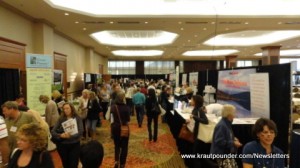 Visit Sponsors Oatmeal Bar Breakfast
The conference began on Friday with an “Oatmeal Bar”. Breakfast was not included in the conference registration fee but was provided as a fundraiser for the Farm to Consumer Legal Defense Fund. I know from experience that I don’t do well with oatmeal for breakfast, even when it is properly prepared. So I bought two boiled free-range eggs and the sausage and biscuits. There were also blueberries, crispy nuts, butter, and cream for the oatmeal, and tea, kefir, local grass-fed milk, fruit and other items for sale.
Tracks
The conference was broken into several “tracks” that were all running at the same time. This made choosing which one to attend difficult. On Friday the tracks were:
I. TRADITIONAL DIETS
Part 1, 2, & 3 by Sally Fallon Morell
II. GUT & PSYCHOLOGY
Part 1, 2, & 3 by Dr. Natasha Campbell-McBride
III. NUTRITION & METABOLISM:
Part 1, 2, & 3 by Stephanie Seneff, PhD
IV. BIODYNAMIC FARMING:
Part 1 – The Biodynamic Preps by Hugh Lovell
Part 2 – Biodynamic Bovine Care by Michael Schmidt
Part 3 – Biodynamic and Practical Bee Care by Christy Hemenway
V. FOOD PREPARATION
Part 1 – Traditional Cooking by Tara Rayburn
Part 2 – Broth Based Soups and Stews by Jessica Prentice
Part 3 – Gluten-Free Sourdough by Sharon Kane
During the first session I was so excited about being at the conference, that I found I couldn’t sit still to listen to any one speaker, so wandered the sponsor’s tables and peeked in on all the talks.
Traditional Diets by Sally Fallon Morell
Sally’s six-hour presentation is well worth attending. You owe it to your self to see it at least once. We have shown a version of this presentation at our Popcorn Review DVD showings, and will show it again sometime in the future.
Gut And Psychology Syndrome (GAPS) by Natasha Campbell-McBride, MD, HMC, CCH
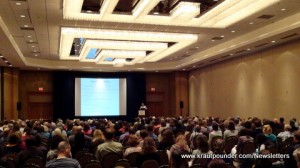 Gut & Psychology Syndrome - Natasha Campbell-McBride, MD When I attended my first Wise Traditions conference in 2007, hearing Dr. Natasha speak was the highlight of my trip. The basis of her talk is that the brain is intimately connected to what is going on in the gut, and that healing the digestive system can clear up many so-called psychiatric or neurological (and physical) disorders. We have shown her presentations at our Popcorn Review in the past, and will probably show this presentation, as I understand that there was new information presented that was not available a couple years ago.
Nutrition and Metabolism by Stephanie Seneff, PhD
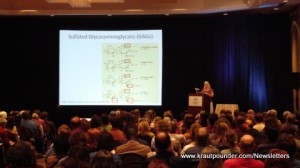 Nutrition and Metabolism - Stephanie Seneff, PhD Stephanie’s presentations are very in-depth and interesting. We have shown two of Stephanie’s presentations at our Popcorn Review. She makes a clear biological case for needing such nutrients as cholesterol, fat and sulfur in the diet.
 Biodynamic Preps - Hugh Lovell Farming Track
This year I didn’t stay in any of the Farming track presentations. In 2009 I spent most of one day in the farming track. I find the farming tracks very interesting even though I am not a farmer. I like to know what good farmers are doing, and what I, as a consumer of farm products should be looking for. I would love to show some of the DVDs from this track to local farmers and consumers.
I mostly attended the Food Preparation track.
Lunch
 Friday Lunch Friday Lunch featured some very interesting coconut wraps, cheese, veggies, salsa, chicken and baked apples for desert.
View the conference menu.
Broth Based Soups and Stews
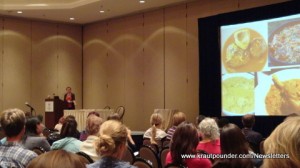 Broth Based Soups and Stews - Jessica Prentice After lunch I attended Broth Based Soups and Stews. Jessica Prentice, owner of Three Stone Hearth in California and author of Full Moon Feast, is a wonderful speaker. She has a great way of grouping together different recipes so that you can see the patterns behind them. In this presentation she talked about how traditional cultures all over the world used similar techniques to make soups and stews. She gave examples of recipes that fell into different categories of cooking techniques. This gave us the opportunity to look at recipes that we decide to make not simply as instructions to follow, but allows us to see the pattern it fits into, and this gives us flexibility to modify the recipe.
Gluten-Free Sourdough
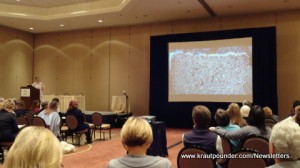 Gluten -Free Sourdough - Sharon Kane For the third session of the day I continued with the food preparation track and attended Gluten-Free Sourdough. Sharon Kane described her experience of learning to make traditional sourdough breads only to discover that she was severely gluten intolerant. She was told on all the sourdough-making sites that gluten-free sourdough was not possible. Through her own perseverance she discovered the process needed to work with gluten-free grains and seeds. She uses kefir (?) to start each batch in order to get the fermentation process going quickly enough to work with these alternative grains. She does not keep a sourdough starter going at all times, but instead usually starts each batch with fresh starter.
 Gluten -Free Sourdough - Sharon Kane At the end of the session Sharon Kane gave us all samples of her Teff-Carob bread. Yummy! She had helpers toasting pieces in the back of the room and the smell was simply wonderful.
I bought her book and hope to be able to teach these recipes sometime in the future.
Friday Dinner
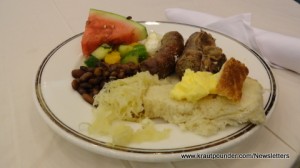 Friday Dinner Pork sausages, pulled pork, baked beans, garlic sauerkraut, potato chips fried lard, bread and lots of butter. For a sweet treat there was watermelon slices drizzled with balsamic vinegar. The sausages were a little too dry by the time I got any, but otherwise fairly good food. I thought the balsamic vinegar on watermelon was a strange combination, but it was nice.
The meals are all eaten at large round tables that hold at least I had a lovely conversation with someone I met at the table. She said she was going to blog about it. I took a picture of her “butter with a little bread”.
 We WAPFers like our butter! This was my neighbor's bread & butter Evening Activities
Sally said that at previous events they used to wonder what people wanted to do in the evening, and tried organizing social events. When conference reviews came back, they found that what attendees wanted was more education!
So in the evening we had the choice of five more activities:
Radical Medicine: “Removing the Obstacles to Cure” by Louisa Williams
Film: The Greater Good by Leslie (Bradshaw) Manooklan
Obesity Myths by Ben Pratt
Cod Liver Oil by David Wetzel
Real Food – Bloggers Panel
Cod Liver Oil
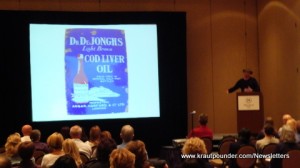 The History of Cod Liver Oil - David Wetzel I attended the presentation on Cod Liver Oil. David Wetzel is the owner of Green Pasture, the first cod liver oil bottler in modern times to make cod liver oil through the original technique of fermentation.
His presentation covered the history of cod liver oil including many photos of original packaging and advertisements for cod liver oil. He outlined the change that occurred when industrial processes of refining, bleaching, deodorizing the oil took over the market. Instead of the advertising focusing on the health benefits of cod liver oil (that were well known at that time) they focused on the tastelessness of the product. They claimed how easy it would be to get your children to take it. They didn’t seem to know or maybe care, that the tasteless product lost most of its nutritional value.
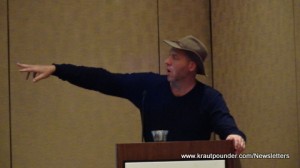 I thought it was a great talk. Unfortunately this presentation was not recorded. I spoke to David Wetzel after his talk and found out that he is willing to come to Eugene (from Nebraska) to give this presentation to us if we have 25 people who are interested in hearing it. Please let me know if you would be interested in hearing this talk. I thought it was a great talk. Unfortunately this presentation was not recorded. I spoke to David Wetzel after his talk and found out that he is willing to come to Eugene (from Nebraska) to give this presentation to us if we have 25 people who are interested in hearing it. Please let me know if you would be interested in hearing this talk.
Traveling Light
This was the first year I attended the conference without my son along. He went to his first conference in Virginia, when he was just barely two, and slept through most of it in a carrier on my chest. He is six now, and had a great time spending the weekend with his grandparents, aunt and cousin. The conference provides childcare and activities for children for a reasonable extra fee. My son did fine in childcare, but I enjoyed “traveling light” this time.
Stay tuned to the Eugene Chapter Newsletters for more highlights from the Wise Traditions 2011 conference.
Wise Traditions 2012
It is not too early to start planning to attend the 2012 conference, which will be in California! Several of us from Eugene will be attending, and I am sure there will be opportunities to carpool, caravan, travel by air, or share rooms together.
I invited all of the Eugene Chapter members who attended this year’s Wise Traditions Conference to write something about their experiences. This comes to us from Kira:
I loved the conference, and my favorite parts included:
- The many vendors and their cool and interesting products.
- The multiple simultaneous good workshops that we could travel in and out of, getting what we needed from each and then moving on.
- The Dallas Sheraton. I appreciated attending my first Wise Traditions in a venue that was clean, had a coffee shop, great gym and nice rooms, so that when I was saturated with information I could retreat and recharge.
- Jessica Prentice’s talk on bone broth. As Lisa knows, since I sat next to her and talked her ear off, I thought her explanation of how to routinize WAPF’s style of cooking (in this case, broth) was brilliant. My one piece of feedback: since the foundation of WAPF is food, there should have been more of those kinds of presentations/PowerPoints.
- I also loved Tom Cowan’s talks, both of them. I love the way he thinks, puts things together, and I think he should always be invited to speak.
- And, lastly, everyone was so friendly. I ate meals with different people everyday and met really cool humans. Everyone should go to at least one of these conferences.
Thanks Kira!
|
Disclaimer The information on this website is provided for informational purposes only... read more |















